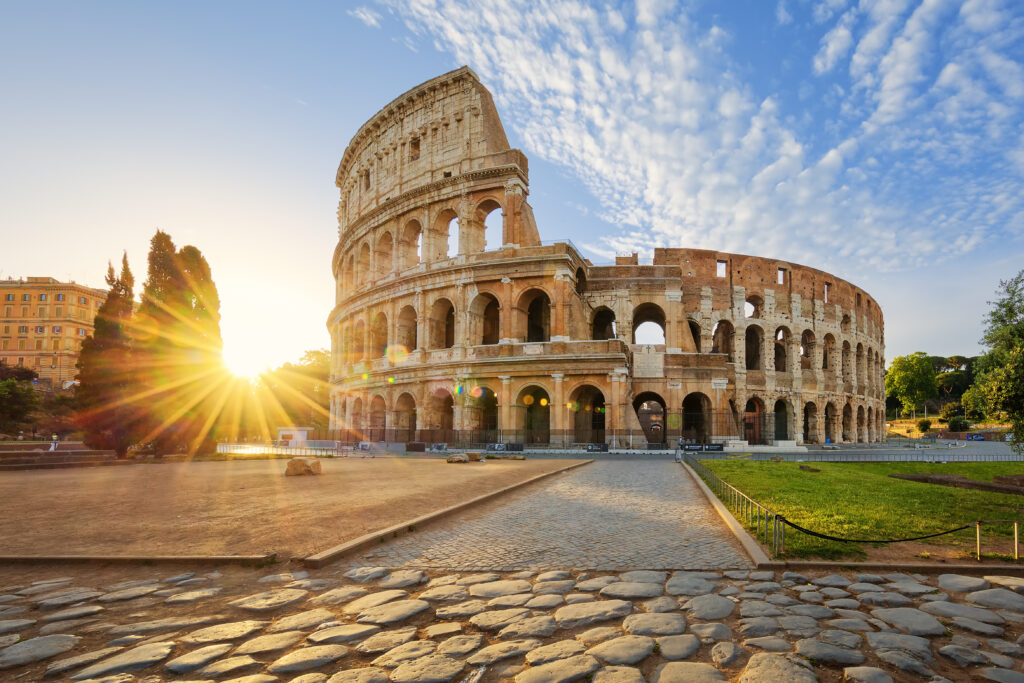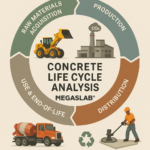Since time immemorial, humans have sought to build structures that stand the test of time. In this quest, one material has stood out for its durability, versatility, and ubiquity: concrete. From the grandeur of ancient Roman architecture to the soaring skyscrapers of modern cities, concrete has been a constant companion in our architectural journey.
The Ancient Roots of Concrete
The story of concrete is as old as civilization itself. Archaeological evidence suggests that the earliest form of concrete was used by the Nabataea traders in regions of Syria and Jordan around 6500 BCE. These early builders discovered the benefits of hydraulic lime, a substance that hardens upon contact with water, and used it to create concrete-like floors, housing structures, and underground cisterns.
In Ancient Egypt, builders used a rudimentary form of concrete made from mud mixed with straw to bind dried bricks. They also used gypsum and lime mortars in their construction projects, including the Great Pyramids, which used about 500,000 tons of mortar.
The Romans, however, were the true pioneers of concrete. By 300 BCE, they had developed a more advanced form of concrete using a mixture of volcanic ash, lime, and seawater. This mixture, known as pozzolana, had the remarkable property of hardening underwater, making it ideal for marine construction.

The Romans used this concrete extensively in their buildings, many of which still stand today. The Colosseum, the largest amphitheater in the world, and the Pantheon, with its massive concrete dome, are a testament to the durability and versatility of Roman concrete.
However, with the fall of the Roman Empire in 476 AD, the art of concrete-making was lost to the Western world.
The Rediscovery and Evolution of Concrete
After the fall of the Roman Empire, the knowledge of concrete was largely forgotten for a thousand years, leading to what can be referred to as the “Dark Ages” of concrete.
The 18th century marked the rediscovery of hydraulic lime and, with it, the return of concrete. John Smeaton, an English engineer, is credited with this rediscovery when he used hydraulic lime to rebuild the Eddystone Lighthouse in Cornwall, England, which had been destroyed in a storm.
The real breakthrough, however, came in 1824 when Joseph Aspdin, a bricklayer from Leeds, invented Portland cement. Aspdin heated a mixture of finely ground limestone and clay until the carbon dioxide was removed. The resulting product, when mixed with water, hardened into a substance as strong as Portland stone, a popular building stone. This invention laid the foundation for the development of modern concrete.
The 19th Century: Industrial Revolution and Concrete
The Industrial Revolution brought about mass production and widespread use of Portland cement. The 19th century also saw the introduction of reinforced concrete, a stronger and more durable form of concrete. French gardener Joseph Monier discovered that embedding iron mesh in concrete made the material more resistant to tension, leading to the development of reinforced concrete.
This period saw the rise of many iconic concrete structures. The Pantheon in Paris, built in the late 18th century, was one of the first major structures to use Portland cement. In the United States, the Ingalls Building, constructed in 1903 in Cincinnati, Ohio, became the first concrete high-rise building.
The 20th Century: Concrete Comes of Age
The 20th century marked a significant shift in the use of concrete, with technological advances such as the development of pre-stressed concrete and high-strength concrete expanding the possibilities of concrete construction. Concrete became the material of choice for constructing everything from bridges and roads to dams and skyscrapers.
In 1936, the construction of the Hoover Dam showcased the impressive potential of concrete. With a total of 3.25 million cubic yards of concrete, it was a massive undertaking that revolutionized the use of concrete in large-scale projects. The dam, located on the Arizona-Nevada border, was the largest in the world at the time of its completion and continues to serve as a vital water supply and electricity source today.
The mid-20th century also saw a significant shift in the use of concrete in high-rise buildings. The construction of Bertrand Goldberg’s 60-story Marina City in Chicago in 1962 sparked renewed interest in using reinforced concrete for high-rises. Marina City, a mid-century modern multi-building development located along the Chicago River, was an urban experiment designed to draw middle-class Chicagoans back to the city after more than a decade of suburban migration. The twin corncob-like residential towers, each with 64 floors, are icons of Chicago architecture and stand as a testament to the versatility and strength of concrete.

Fast forward to the end of the 20th century, the Burj Khalifa in Dubai, completed in 2009, achieved the title of the tallest building in the world with its height of 829.8 m (2,722 ft). It used more than 330,000 cubic meters of concrete, proving that concrete was still the material of choice for large-scale projects. The tower’s innovative use of bundled tube structural design, which relies heavily on concrete, has influenced the construction of skyscrapers worldwide.
These examples highlight the incredible advances made in concrete technology over the past several millennia. From its humble beginnings as a mud and straw mixture used to build homes to the massive structures of today, concrete has come a long way. Its versatility, strength, and durability have made it an essential building material that continues to shape our world.
Modern Concrete and Its Role in Architecture
As the calendar turned to the 21st century, the evolution of concrete did not slow down but rather accelerated, with new forms of this versatile material pushing the boundaries of what was possible in construction and architecture.
One of these groundbreaking innovations was self-healing concrete. This marvel of bioengineering, which has been under development and testing since the early 21st century, uses bacteria to heal cracks that appear over time. This not only prolongs the lifespan of concrete structures but also significantly reduces maintenance costs.
Another significant innovation that emerged in the 21st century was translucent concrete. By incorporating optical fibers into the concrete mix, light can pass through, giving the concrete a translucent appearance. This has opened up new possibilities for architectural design, offering a unique aesthetic and potentially reducing the need for artificial lighting.
Concrete’s strength, durability, and versatility have made it a favorite material in modern architectural design. From Zaha Hadid’s flowing concrete forms to Tadao Ando’s minimalist concrete structures, architects have embraced concrete for its ability to shape the built environment.
The Science and Technology Behind Concrete
The cement industry has played a pivotal role in the evolution of concrete. From the manufacturing process of cement to the careful selection of constituent materials, the science behind concrete is complex. The concrete mix often includes supplementary cementitious materials like blast furnace slag and granulated blast furnace slag, enhancing specific qualities like strength gain and environmental sustainability. Innovations like high-performance cement paste have enabled the creation of unconventional concrete, such as translucent and self-healing variants.
Concrete in Transportation: Roads, Bridges, and Airports

Concrete’s role in transportation infrastructure is monumental. From highways and parking lots to bridges and airport runways, concrete is the preferred construction material. The use of precast concrete and concrete reinforced with fibers has revolutionized the construction of resilient and long-lasting structures. Concrete plants play a vital role in ensuring the quality and consistency of fresh concrete, meeting the demanding specifications of modern transportation projects.
Decorative Concrete: Art and Aesthetics
Decorative concrete has transformed ordinary concrete into an artistic medium. Techniques like staining and stamping create visually appealing surfaces in concrete buildings and public spaces. The local availability of materials and skilled craftsmanship can influence the success and aesthetics of decorative concrete projects.
Challenges and Solutions in Concrete Construction
Concrete construction faces challenges such as cracking in hardened concrete and shrinkage in fresh concrete. Modern solutions include the use of synthetic fibers, special admixtures, and innovative construction techniques like 3D printing at the construction site. Recycled concrete and the use of alternative fuels in cement kilns are part of the industry’s efforts to reduce its carbon impact.
Concrete and Society: Economic and Social Impacts
Concrete’s impact on society extends beyond concrete buildings and infrastructure. The cement content and energy required in production have significant environmental implications, including global warming. Efforts to improve energy efficiency and explore alternative materials like blast furnace slag reflect the industry’s commitment to sustainability.
Global Concrete Usage
Global concrete usage varies widely, reflecting economic development, cultural preferences, and environmental considerations. Concrete producers are exploring innovative materials like supplementary cementitious materials and alternative fuels to reduce environmental product declarations. The balance between conventional concrete and sustainable alternatives is a dynamic and evolving aspect of the global construction landscape.
Concrete Recycling and Environmental Considerations
Concrete recycling is vital for sustainable construction, turning demolished concrete into coarse aggregate for new projects. The use of recycled concrete and by-products like fly ash reduces waste and supports a circular economy. However, standardization and data collection remain challenges in making recycling a mainstream practice.
Safety and Regulations in Concrete Industry
Safety and regulations in the concrete industry encompass worker protection, material quality, and environmental compliance. Fire resistance, compressive strength, and adherence to global standards are essential aspects of quality control. The General Services Administration and other regulatory bodies oversee these standards, ensuring integrity and safety in concrete construction.

The Emergence of Green Concrete
As the 21st century progressed, the construction industry began to feel the increasing pressure of environmental sustainability. This led to the rise of green concrete, a concept that originated in the late 20th century but only gained significant traction in the 21st century.
Green concrete, also known as low-carbon concrete, has become a key player in efforts to reduce carbon emissions in the construction industry. It utilizes recycled industrial materials such as slag and fly ash, which not only reduces waste but also significantly lowers the carbon footprint of concrete.
The development of green concrete was a response to the growing awareness of the environmental impact of construction activities. Traditional concrete production is responsible for approximately 8% of global CO2 emissions, making it one of the largest industrial contributors to climate change. Green concrete offers a more sustainable alternative that can help to reduce this impact.
MEGASLAB Innovation: A Leap Towards Sustainable Concrete
At MEGASLAB, we’ve always been driven by innovation and a commitment to sustainability. Recognizing the environmental impact of traditional concrete production, we set out to revolutionize the industry. Our goal was to create concrete that was not only stronger and more durable but also significantly reduced CO2 emissions.
Our journey began with extensive research and testing. We explored emerging nanotechnologies and conducted numerous tests on various fibers, blends, types, and dosages. This rigorous process allowed us to understand which combinations worked best for various applications.
The result of our efforts is the MEGASLAB – an engineered concrete solution that redefines performance. Our concrete uses less cement yet delivers unmatched strength and durability. But what sets us apart is our commitment to sustainability. Our concrete can reduce CO2 emissions by up to 50%, making it a leader in the industry for carbon reduction.
The benefits of MEGASLAB are beyond just environmental. Our concrete reduces joint usage by up to 95%, significantly bolsters impact and abrasion resistance, and can be used in a variety of industrial applications.
MEGASLAB is proud to be a part of the concrete evolution, working with leaders in the industry and pushing the boundaries of sustainable concrete technology. We have embraced the challenge of creating a more sustainable future for our industry and look forward to continuing our mission in the years to come.
From its humble beginnings in prehistoric times to its modern incarnations, concrete has proven to be a remarkably adaptable material. Its evolution is a testament to human ingenuity and the relentless pursuit of progress. As we look to the future, it is clear that concrete will continue to play a crucial role in shaping our built environment. Whether it’s in the form of towering skyscrapers, sprawling bridges, or innovative green solutions, concrete is, and will remain, the foundation of our world.
Additional Resources
For further exploration into the world of concrete and its modern applications, consider these resources:
- Why is MEGASLAB the Modern-Day Roman Concrete?
- Discover howMEGASLAB’s technology parallels the innovations of ancient Roman concrete, offering modern solutions with historical roots. Learn more about MEGASLAB as the modern-day Roman concrete.
- Automated Storage and Retrieval Systems
- Understand how concrete plays a crucial role in the infrastructure of automated storage and retrieval systems, a key component in modern logistics and warehousing. Explore automated storage and retrieval systems.
- Food & Beverage Industry Applications
- See how MEGASLABs concrete solutions are applied in the food and beverage industry, showcasing the versatility of concrete in various sectors. Read about concrete applications in the food & beverage industry.
- See It In Action
- Witness the practical applications and effectiveness of MEGASLAB’s concrete technology in real-world scenarios. View concrete solutions in action.




